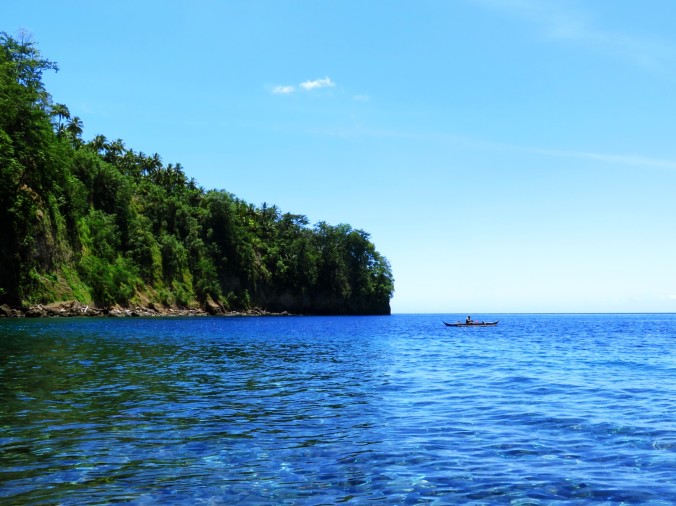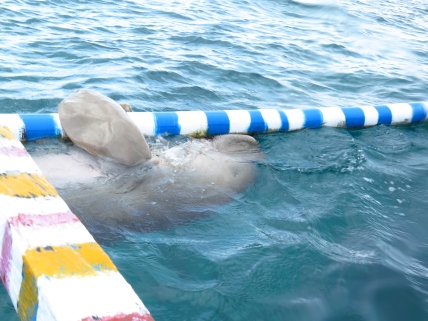In the previous blog I described how my colleague Alessia and me explored Alor, on a mission to collect environmental DNA and study Indonesia’s remote reefs. I am still stuck at home in corona times, so what follows is the next leg of our trip. After we left Alor, we headed to an island that’s been a tempting dot on Indonesia’s map for a while: Sangihe. This particular trip was supported by a National Geographic grant to investigate Indonesia’s remote reefs.

The tiny speck on the map that is Sangihe Island
To get to Sangihe, you have to pass through Manado, from there you can either take a long ferry ride or a tiny plane very early in the morning. Flying to the island is a great way to admire the volcanic activity that has formed the islands. Multiple volcanoes surround the airport in Manado and you fly over a few more dotted in the Celebes sea before landing in Sangihe, which has its own large volcano (Gunung Awu).

Fisherman in Sangihe. Photo credit: Maarten De Brauwer
The island itself is gorgeous, covered in forest with deep blue water around it. Being so remote, the place gets few divers, so dive facilities are nearly non-existing. When we were there (March 2020), the only place to rent equipment was the tourist info centre in Tahuna. Jemmy, who runs the shop is a great guy who went out of his way to help out were possible. Logistics were not quite on point yet since he only started in the scuba business a few weeks before we got there, but fieldwork logistics rarely are on point, so we still got to explore and collect the data we needed.

Sangihe boat views. Photo credit: Maarten De Brauwer
What stuck with me most about the sites, is the incredible visibility, which was 30m at the worst of times and up to 50m at some of the best spots. Otherwise, the health of the reefs was not as good as I hoped it would be. Some sites had extensive dynamite damage, others looked like they had bleached, and the northern sites were strangely devoid of coral, but also lacked the evidence of any typical human impacts. Bare in mind that we were exploring, and neither our fixer Jemmy, nor the boat driver had taken divers or snorkelers to most of the places we sampled. So there was a lot of searching, looking for spots, and the times we got it right, diving was as good as some of the very best Indonesia’s got to offer.

Not a bad place to sample eDNA. Photo credit: Maarten De Brauwer
One of the cooler experiences during our time in Sangihe was exploring a small freshwater creek that entered the sea at the beach where we were having a surface interval. This small, fast-flowing river wasn’t only absolutely stunning to look at, it was also home to some very exciting fish life. Besides some very cute blue streamgoby (Sicyopterus lagocephalus), it also sheltered a healthy population of freshwater pipefish (Microphis retzii)!!! While I knew they existed, I had never seen them myself, so discovering a creek full of them definitely made my day!
Unfortunately, the next leg of the trip was cancelled due to the spread of COVID19. We were planning to head to an ever more remote island (Pulau Talaud), but the risk of getting stuck there grew a bit too serious. We managed to get a short sampling trip in at the more accessible Bangka island, but eventually had to cut our time short there as well. After only 2 nights on the island, we were told by both the university and friends in the government that the safest course of action would be to leave the country and head back to Europe. Where, at the time of writing, I still am…
A small word of warning for those of you reading this and feel like going for a diving adventure. Sangihe is proper frontier diving with lots of exploring to do. The island has few other sources of income than fishing and coconut farming, so tourism could boost livelihoods in the areas. Just be aware that safety protocols are not as well-established as they are in other, more touristy areas of Indonesia. You should be an experienced scuba diver who can deal with strong currents, basic conditions, and limited to no safety backup from operators.

Yellowfin tuna for sale at Tahuna market. Photo credit: Maarten De Brauwer

Tuna head was had. Photo credit: Maarten De Brauwer

A man and his skipjack tuna. Photo credit: Maarten De Brauwer






















